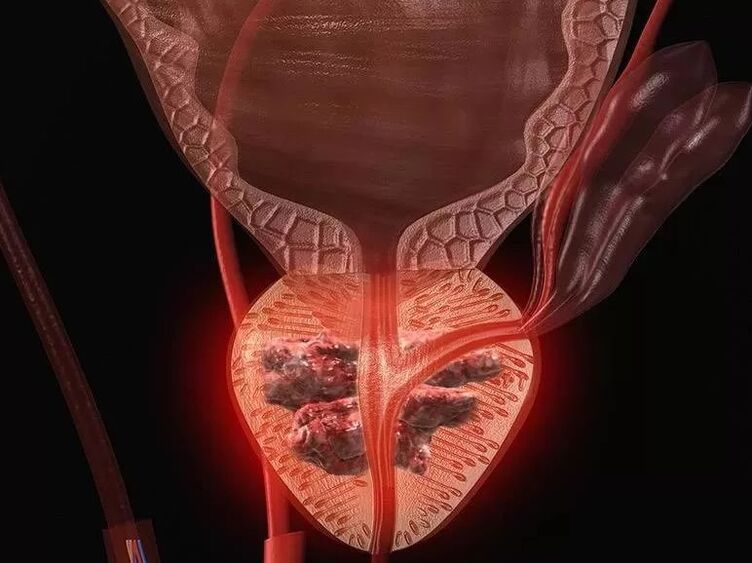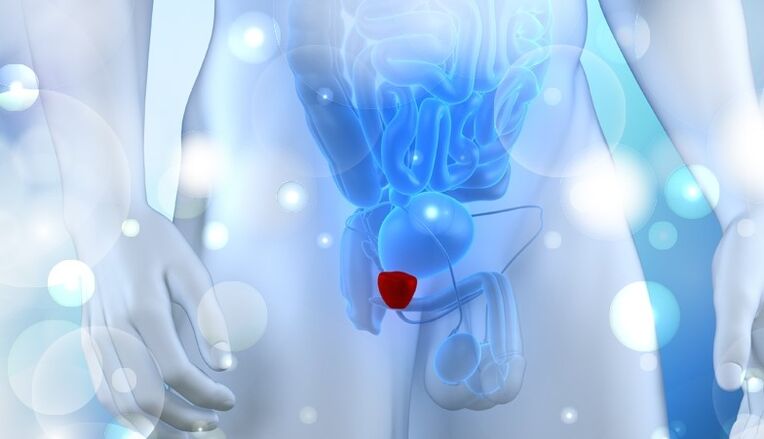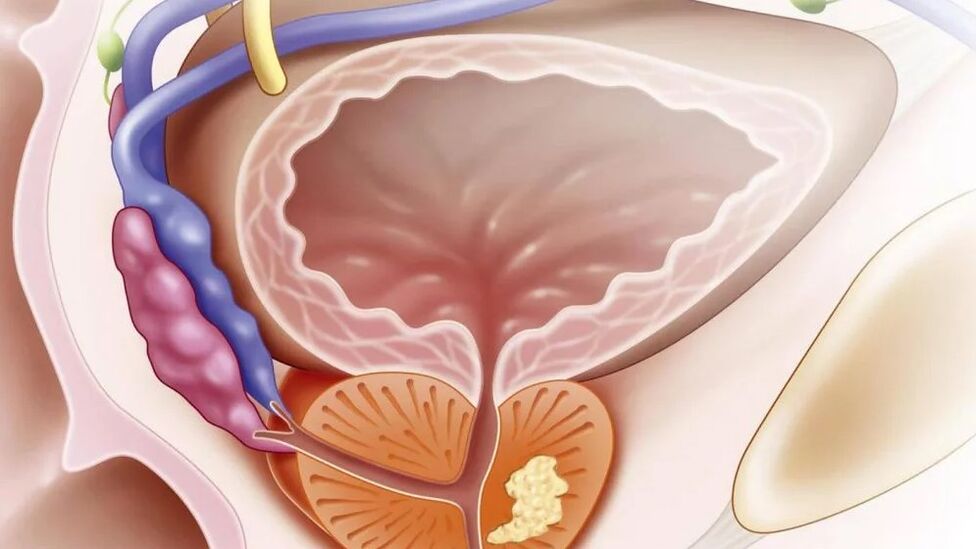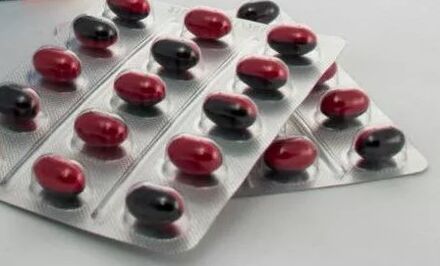One of the most dangerous complications of acute prostatitis can be an abscess of the prostate gland. This is a purulent focal inflammation, in which body temperature can rise to 40 degrees. Signs of abscess are acute intense pain and difficult urination. In the absence of medical care, swelling of the glandular tissue develops and the urethra lumen is completely blocked.

Prostatitis is the most common urological pathology in men of reproductive age. According to surveys, each third of them at least once in his life experienced symptoms that could be interpreted as inflammation of the prostate gland. The main cause of the development of bacterial prostatitis is an infection, however, only in the case of acute prostatitis, the infection leads to a sharp inflammation of the prostate gland, which is explained by the anatomical features of the male body structure.
In the chronic form of prostate, the infection can also be the cause, the mechanism of inflammation, but the inflammation of the prostate gland, which requires treatment, can only develop against the background of other factors:
Prostatitis: Consequences
In the event of premature appeal to the urologist, acute bacterial prostatitis can lead to the formation of an abscess and edema of the prostate gland, which is able not only to complicate the urination but make it completely impossible.
The latter, like inflammation, can cause serious intoxication of the body, characterized, among other things, from a sharp increase in temperature to 40-41 ° C (with sharp temperature fluctuations within 1 degree).
However, most often complications of this type can be avoided, as manifestations of prostatitis of this species usually force the patient not to delay visiting a specialist.
In the case of a chronic form of the disease, the symptoms of which are not so pronounced, the development of complications without proper treatment and in time is quite possible. Without proper medicine and therapeutic effect, inflammation can spread to other organs of the genitourinary system, which can lead to development:

It should be remembered that inflammation of the eggs and testicles is one of the most common complications and can cause male infertility, which, in turn, is treated for a long time, difficult and not always successful, so the faster to treat prostatitis, the more chances of avoiding complications of this kind.
In some cases, the consequence of chronic prostate may be its transition to a form of calculation. The calculation prostate is characterized by the formation of calculations (small pebbles) in the excavating canals of the gland, to get rid of which is very medicine.
Moreover, the cause of prostatitis is a hormonal failure caused by insufficient production of hormones with the sexual glands.
Prostatitis development is facilitated by a number of certain causes. Very often, signs of prostate manifest in those men who commit irregular sex life, often undergo hypothermia and damage.
Moreover, prostate can develop as a result of a decrease in immunity, worsening blood flow and lymph circulation in small human pelvic men, as a result of a hormonal failure, which provokes a certain level of androgen failure.
A factor that contributes to the manifestation of the prostate is also considered a number of sexually transmitted infections. Therefore, prostatitis often manifests in men after unprotected relationships.
There are 4 main forms of prostatitis: acute bacterial prostatitis, chronic bacterial prostatitis, non -bacterial prostatitis and prostatitis.
In people under 35, the disease usually continues in the form of acute bacterial prostate. Bacterial prostatitis is called when there is laboratory confirmation of the presence of infection.
Most often, it turns out to be Chlamydia, Trichomoniasis, Gardnerellosis or Gonorrea. The infection enters the prostate gland from the urethra, bladder, rectum, through blood and pelvic lymph vessels.

However, recent studies prove that in most cases, the infection is stratified in existing concerns in the structure of the prostate tissue and blood circulation in it. With non -bacterial prostatitis, bacteria cannot be isolated, though this does not exclude their presence.
In older patients, chronic forms of the disease are more often diagnosed. Prostatodine is called the presence of a clinical appearance of prostatitis, a seal of prostate tissue without signs of its inflammation.
ClaSSIFICaTION
In accordance with the criteria of the American National Institute of Health (NiH USA), four categories of prostatitis are distinguished by 1995:
Currently, an international prostate classification has been adopted, which is more complete and covers all kinds of inflammation:
Subcategory III A. Chronic inflammatory pelvic pain syndrome (leukocytes are determined in the secret of the prostate);
Subcategory III B. Chronic Pain Syndrome Non -Inflammatory Pelvic (no leukocytes in prostate secret);
Prostatitis treatment varies depending on that form of disease in a human. So bacterial prostatitis can occur in both acute form and as a chronic disease.
Very often, non -bacterial prostatitis is also diagnosed as a chronic disease. Such a variety of prostatitis is also called a chronic pelvic pain syndrome.
In such patients, all the characteristic symptoms of the prostate are observed, but there are no bacteria in the secret of the prostate.
Acute bacterial prostatitis is characterized by rapid development. At the same time, a person suffers from severe pain, there are signs of general intoxication. Symptoms in the chronic form of the disease are much less manifested. In this case, the disease is gradually manifested.
And if the prostatitis course of the acute form, as a rule, ends with the complete healing of the disease, then with chronic prostatitis, relapses appear quite often. This should be taken into account in the treatment of prostate at home. Moreover, in the presence of inflamed stones in the prostate gland, disease therapy is a more complex process.

With non -bacterial prostatitis (chronic pelvic pain), a person develops severe pain that is localized in the pelvic area, genitals and perineum. There are no signs of inflammation in the prostate.
This disease is common among modern men of different age groups, but most often the disease affects people of 35-45 years. To date, experts express some assumptions on what are the causes of this form of prostate.
So there is a theory that this syndrome provokes damage to the tissues of a bacterial prostate. In addition, there is an opinion that the disease manifests itself due to the urine that falls into the prostate gland.
As we have already said, the acute and chronic course of the disease is possible. In this case, the appearance of acute prostatitis is most often provoked by gram-negative bacteria.
This form of the disease is relatively easy to diagnose and treat by taking antibiotics. At the same time, cases of non -bacterial chronic prostatitis are very often found in men, which is more difficult to diagnose and has nothing to do with a certain infectious lesion.
Therefore, in the case of chronic prostate, antibiotic treatment will not be able to give the right effect. According to statistics, about 35% of men over fifty years old, chronic prostate.
Treatment of chronic and acute prostatitis
In the case of prostate signs, both acute and chronic, you should consult a urologist who will determine what kind of diagnosis develops, and you will also help cure the disease and strengthen the body as a whole. It should be remembered that this applies evenly to both types of prostate, each of which can lead to its complications.
Priority
The main reception of a specialist includes a study and examination of the patient (including the rectal, which allows you to determine the extent and nature of the prostate gland growth), as well as the appointment of necessary tests and other diagnostic measures.
The first and important sign of the prostate is the damaged urination that causes discomfort. Another sign of the disease is rapid urination, but in which urine comes out in small parts.
Symptoms of acute form of the disease

The disease is suddenly formed and is characterized by pronounced manifestations.
Body every male body is individual, and symptoms can manifest separately, or all immediately.
Signs of a chronic form of disease
Chronic prostatitis is usually characterized by the same signs, however, continues with less pronounced symptoms.
Moreover, the following manifestations can be observed:
The first signs of prostate, to which a man should pay attention and contact the urologist:
Prostatitis treatment is performed depending on the form of the disease. Acute inflammation is an indicator of hospitalization of the patient in the urological hospital, with chronic patients undergoing the course of home therapy. If the cause of the disease was a sexually transmitted infection, both partners should take antibiotics.
In the treatment of acute prostatitis, it is important that systemic antibacterial treatment is important.

The main drug groups include:
Massage
This procedure is one of the most effective methods for treating prostatitis. Thanks to it, accumulated in the prostate gland, the secret is squeezed from it, and then removed independently through the urethra. Moreover, prostate massage helps improve blood supply to the glandular tissue, which increases the effectiveness of antibacterial and local therapy.
Physiotherapy
Physiotherapeutic treatment helps improve trophism of the prostate gland tissue and accelerate the recovery process. The following methods of physiotherapy are possible:
drill
The main signs of the disease
A disease such as prostatitis in most men suddenly develops. In the patient, the temperature increases significantly, a feeling of weakness, fever appears. The main sign of prostate inflammation is severe pain in the perineum, which gives the pubic area, anal opening, sacrum. During urination, defecation and with any other tension of the pelvic muscle, the pain increases.






























